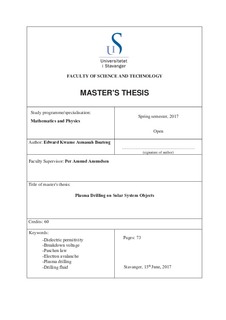| dc.contributor.advisor | Per Amund, Amundsen | |
| dc.contributor.author | Asamoah Boateng, Edward Kwame | |
| dc.date.accessioned | 2017-09-08T07:58:16Z | |
| dc.date.available | 2017-09-08T07:58:16Z | |
| dc.date.issued | 2017-06 | |
| dc.identifier.uri | http://hdl.handle.net/11250/2453676 | |
| dc.description | Master's thesis in Mathematics and Physics | nb_NO |
| dc.description.abstract | The search for water, minerals and most importantly evidence of life on other objects of our solar system will require access to the subsurface for sampling and in situ investigations. Drilling is therefore needed for this task, but present drilling technologies on Earth will be difficult to apply on such objects. Therefore, some novel alternatives will be needed for successful drilling. This work focuses on one promising method introduced by Zaptec AS, which is plasma channel drilling (PCD), where a rock is fragmented with high voltage pulses. The PCD process require an isolating medium for its operation, usually water, around the electrodes (drill bit). Very fast high voltage pulses are applied to the rock surface, causing the rock to fail electrically. The electrical breakdown creates a channel of plasma in the rock, which by thermal expansion causes mechanical fragmentation. This work seeks to investigate the feasibility of the PCD process in extra-terrestrial environments and to check the possibility of using compressed gas instead of water which has been used and proven effective on Earth. Furthermore, an attempt to optimize the field around the Zaptec drill head was done with Comsol Multiphysics software.
The difference in breakdown strength between rocks and fluid is crucial, hence the breakdown strength is reviewed, calculated with the Paschen law and compared to estimate the feasibility of PCD when using the atmosphere of planets and other objects as drilling fluid. Several related subjects are also briefly discussed, like the challenges and successes of drilling on other solar system objects and some of the many high voltage mechanisms that happens in sparking. Past and ongoing drilling technologies for space applications are also reviewed. PCD seems feasible on Titan which has similar breakdown strength as Earth but unlikely on Mars with a breakdown strength of only 0.74 kV/cm. Asteroids and comets and Europa which is essentially vacuum present the best environment for PCD. The use of gas as drilling fluid seems highly unlikely but will require further research in to that area of study. | nb_NO |
| dc.language.iso | eng | nb_NO |
| dc.publisher | University of Stavanger, Norway | nb_NO |
| dc.relation.ispartofseries | Masteroppgave/UIS-TN-IMN/2017; | |
| dc.subject | dielectric permitivity | nb_NO |
| dc.subject | breakdown voltage | nb_NO |
| dc.subject | paschen law | nb_NO |
| dc.subject | electron avalanche | nb_NO |
| dc.subject | plasma drilling | nb_NO |
| dc.subject | drilling fluid | nb_NO |
| dc.subject | matematikk | nb_NO |
| dc.subject | fysikk | nb_NO |
| dc.title | Plasma drilling on solar system objects | nb_NO |
| dc.type | Master thesis | nb_NO |
| dc.subject.nsi | VDP::Mathematics and natural science: 400 | nb_NO |
